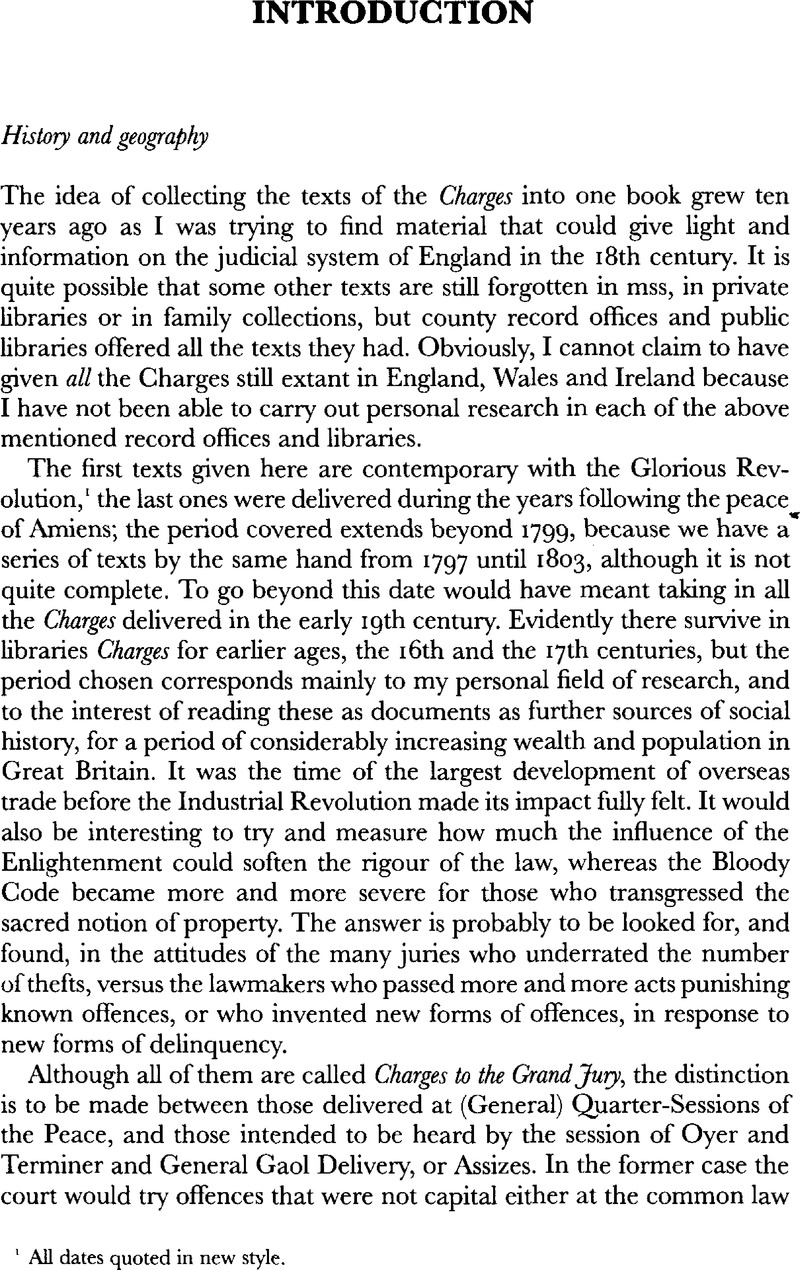No CrossRef data available.
Article contents
Introduction
Published online by Cambridge University Press: 21 December 2009
Abstract

- Type
- Introduction
- Information
- Copyright
- Copyright © Royal Historical Society 1992
References
page 3 note 1 All dates quoted in new style.
page 5 note 1 See Beattie, J. M., “London Juries in the 1690s,” 223Google Scholar, n. 17 in: Cockburn, J. S. & Green, T. A., eds., Twelve Good Men and True, The Criminal Trial Jury in England, 1200–1800 (Princeton, N.J.: Princeton U.P., 1988)Google Scholar. — The same article contains interesting evidence as to the simultaneity of the London Q-S. and Gaol delivery and O. & T. sessions, 222–23.
page 6 note 1 ed. D.M. Walker (OUP, 1980), p. 206. See R. Burke.
page 7 note 1 Williams, Penry, “The Crown and the Counties” in: Chr. Haigh, ed., The Reign, of Elizabeth (London: Macmillan, 1984) 126.Google Scholar
page 10 note 1 See the opening lines of Fielding, H.'s An Enquiry into the Causes of the late Increase of Robbers…, 1751, ed. Lamoine, G. (Toulouse: P.U.M., 1989)CrossRefGoogle Scholar
page 12 note 1 One only text gives the list of the members of the bench. One jury is a special jury of constables.
page 13 note 1 Cf Cockburn, J. S. & Green, Th. A., Twelve Good Men and True… (Princeton U.P., 1988) ch. 9 & 10, passim.CrossRefGoogle Scholar
page 14 note 1 Thompson, E. P., Whigs and Hunters, 1975 (Peregrine Books edition, 1977).Google Scholar
page 14 note 2 In this field statistical data are nearly impossible to obtain; the 18th century figures collected by Sir Theodore Janssen were destroyed during World War II; see Lamoine, G., ed., Bristol Gaol Delivery Fiats 1741–1799 (Bristol Record Society, vol. XL, 1989)Google Scholar, and Littérature et justice pénale en Angleterre au 18° siècle (Paris; Didier-Erudition, 1987), iv, 132–37.Google Scholar
page 14 note 3 Before the act of Parliament passed under James I so often quoted hereafter, there had been attempts at legislating (e.g. in Coventry and York) “against the preference of the ‘poorest sorte’ ‘to sytte all daye in halehouse…’” cf Palliser, D. M., The Age of Elizabeth (Longman, 1983) iii, 62.Google Scholar
page 15 note 1 H. Fielding had already denounced perjury and false witnesses in his Enquiry into the Causes of the late Increase of Robbers, only a few years earlier.
page 16 note 1 For which texts see infra.
page 19 note 1 See Jacob, G., New Law DictionaryGoogle Scholar, under: evidence, examination: “the Accusers must be bound to appear and give Evidence at the next Assise, & to which the Examinations must be certified.” — Evidence: “Is used in the law for some Proof, by Testimony of Men on Oath, or by Writings or Records.” Burn, R., The J.P. and Parish Officer, 2 vols. (1755): I, 286–94Google Scholar, v: Of the manner of giving Evidence: 1.— The evidence both for and against a prisoner ought to be on oath. 4.— In cases of life, no evidence is to be given against a prisoner, but in his presence. 2 Hawk. 428Google Scholar. 7.— A witness shall not be permitted to read his evidence, but he may look upon his notes to refresh his memory. St. Tr. V, 4, 45.”
page 21 note 1 See O'Carroll, Joseph, “Contemporary Attitudes towards the Homeless Poor 1725–75,” in Dickson, D., ed., The Gorgeous Mask Dublin 1700–1850 (Dublin, 1987)Google Scholar Information kindly supplied by the Assistant Librarian of King's Inn Library.




